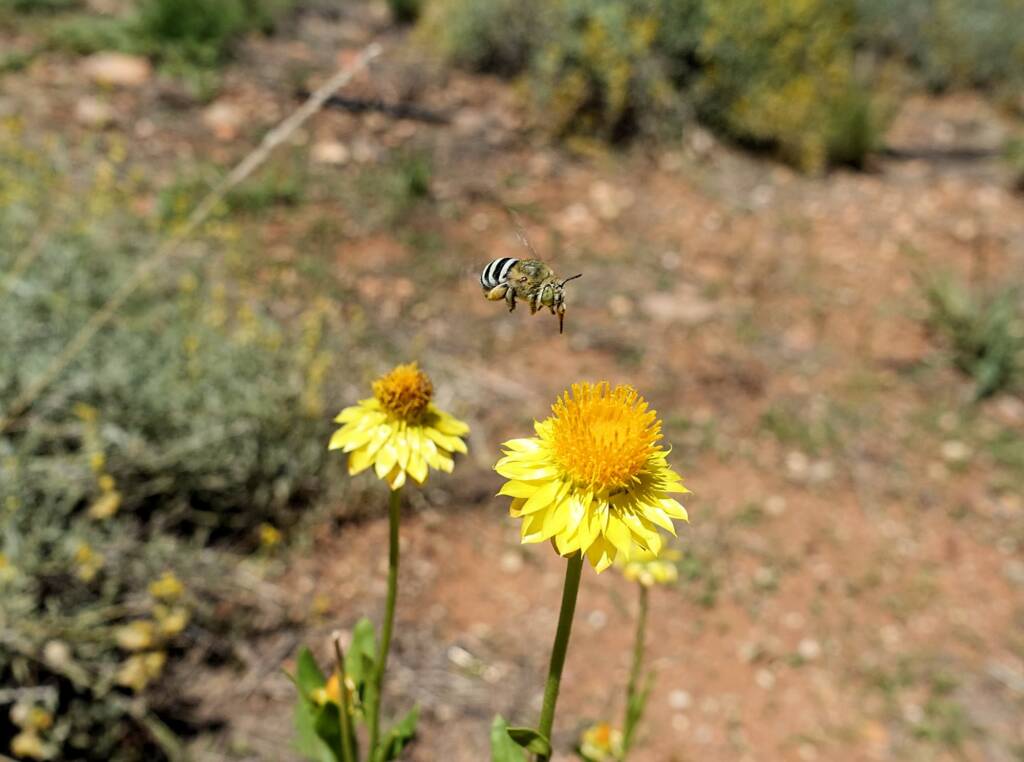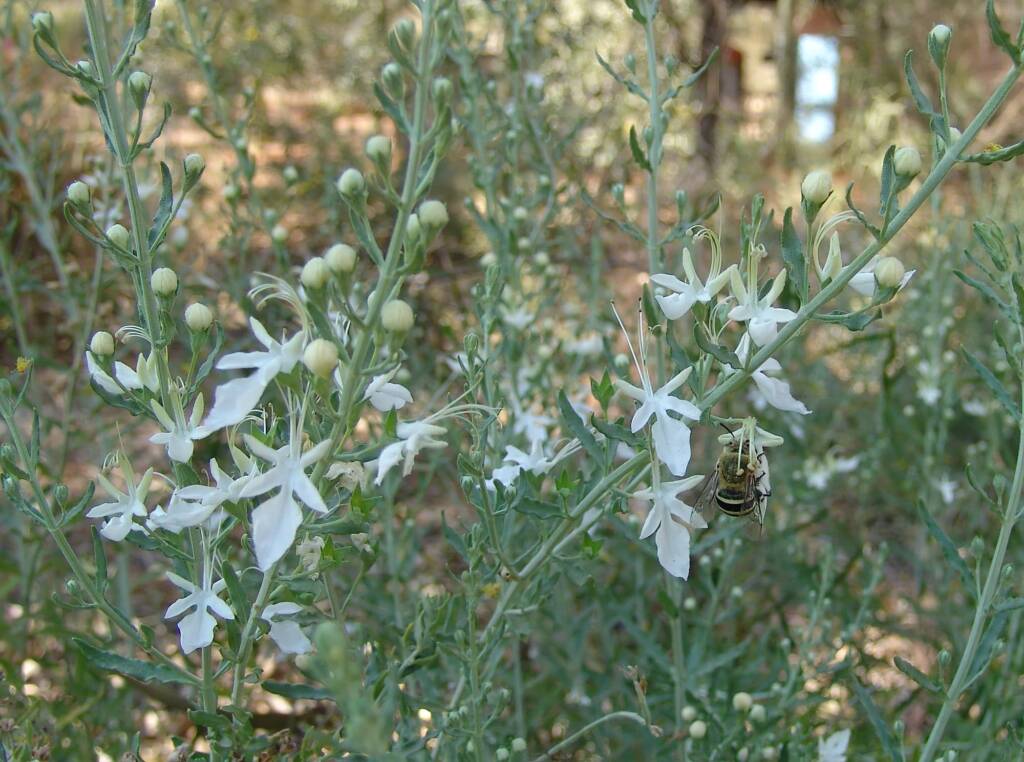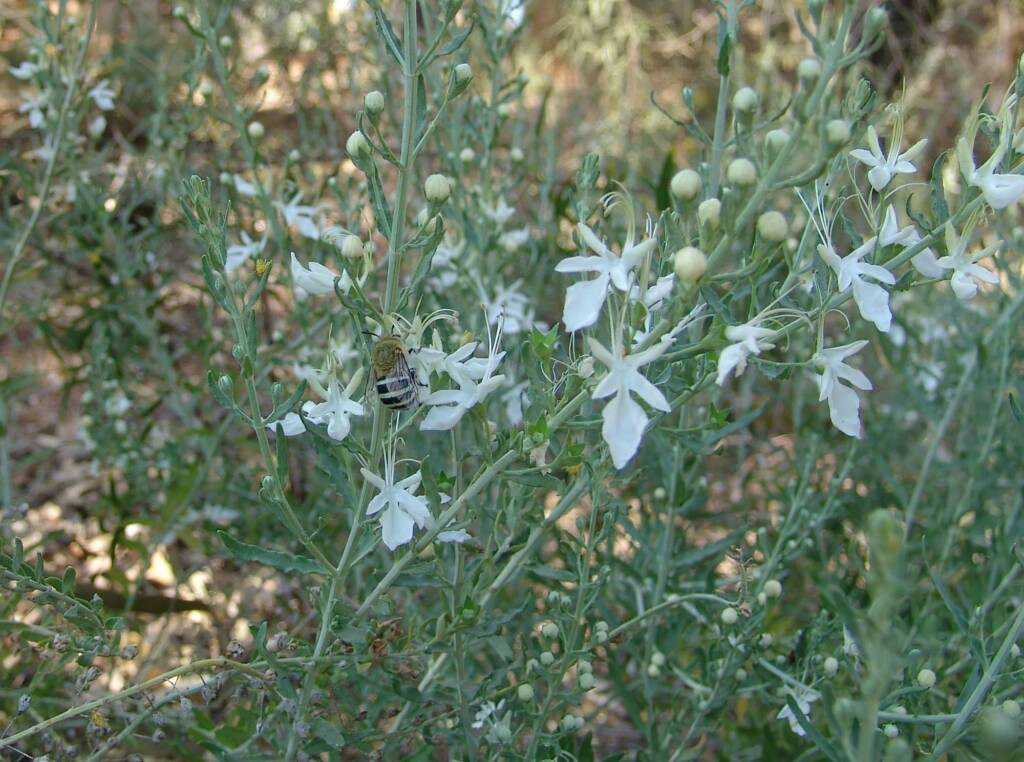Amegilla chlorocyaneaAmegilla chlorocyanea – blue-banded Amegilla chlorocyanea – bubbling bee
Pictured here is the species Amegilla chlorocyanea bee, commonly known as the Blue-banded Bee. It is a small robust looking bee with a golden to light-brown head and thorax. The abdomen is black with blue stripes, although their stripes can appear to be cream-white in colour, sometimes with a light hint of blue.

Native to Australia, they are a solitary bee that do not live in colonies. The Amegilla chlorocyanea are known to collect nectar from a variety of plants, including blue flowers and as picture here the Golden Everlasting (Xerochrysum bracteatum).
The Amegilla collect pollen through a process called ‘buzz pollination’, where the bees hang onto the flowers of certain plant species and shake them at a specific frequency enabling the releasing of the nectar and pollen. As a consequence these bees are a significant pollinator of many types of crops such as tomatoes and eggplants.

Whilst these bees can sting, they are not known to be aggressive.
Visitors to Central Australia, should keep their eyes out for these wonderful small insects and other native bees. Important for pollination and our flora diversity bees such as the Blue-banded Bee are an interesting species to see. The Amegilla chlorocyanea pictured here were sighted at the Alice Springs Desert Park.




The following Amegilla photographed at Olive Pink Botanic Garden on the Grey Germander (Teucrium racemosum).
Check out the Blue Banded Bees project by researchers at Western Sydney University. There are images and video including examples of man-made bee hotel etc.
- Scientific classification
- Kingdom: Animalia
- Phylum: Arthropoda
- Subphylum: Hexapoda
- Class: Insecta
- Informal: Pterygotes
- Order: Hymenoptera
- Superfamily: Apoidea
- Informal: Apiformes
- Family: Apidae
- Subfamily: Apinae
- Tribe: Anthophorini
- Genus: Amegilla
- Subgenus: infrageneric Notomegilla
- Species: Amegilla chlorocyanea

Footnote & References
- Blue Banded Bees, Western Sydney University, https://www.bluebandedbees.org/
- Amegilla (Notomegilla) chlorocyanea (Cockerell, 1914), Blue Banded Bee, Atlas of Living Australia, https://bie.ala.org.au/species/urn:lsid:biodiversity.org.au:afd.taxon:b443cb35-54f0-4fc7-a157-74669482375d
- Blue banded bee, PaDIL – Department of Agriculture, Water and the Environment, the Department of Primary Industries and Regional Development, Western Australia, Museums Victoria and Plant Health Australia, https://www.padil.gov.au/pollinators/pest/main/138580
- Amegilla (Notomegilla) chlorocyanea, Friends of Queens Park Bushland, https://www.friendsofqueensparkbushland.org.au/amegilla-chlorocyanea/
- Amegilla bees, BioNET-EAFRINET, https://keys.lucidcentral.org/keys/v3/eafrinet/bee_genera/key/african_bee_genera/Media/Html_eafrica/Amegilla_bees.htm
- Foraging behaviour of a blue banded bee, Amegilla chlorocyanea in greenhouses: implications for use as tomato pollinators, EDP Sciences, Apidologie, Volume 38, Number 1, January-February 2007, Page: 86-92, https://www.apidologie.org/articles/apido/abs/2007/01/m6068/m6068.html
- Many thanks to Kit Prendergast for identifying this native bee from the Facebook Bees in the burbs (now known as The Buzz on Wild Bees, https://www.facebook.com/groups/Beesintheburbs/
Amegilla chlorocyaneaAmegilla chlorocyanea – blue-banded Amegilla chlorocyanea – bubbling bee
Amegilla BeeApical tergites of females Amegilla Body Colour Amegilla adelaidae Amegilla aeruginosa Amegilla asserta Amegilla chlorocyanea Amegilla walkeri Teddy Bear Bees (Asaropoda)
BeesBees Anatomy Bee Behaviour Blogging Bees… Bees – image index Amegilla Bee Apis mellifera Austroplebeia australis Austrothurgus Braunsapis sp Ceylalictus perditellus Colletidae Euryglossinae Exoneura Homalictus Hyleoides bivulnerata Lasioglossum Lasioglossum (Chilalictus) Lipotriches Megachile Meroglossa Stenotritidae Tetragonula Thyreus Xylocopa








